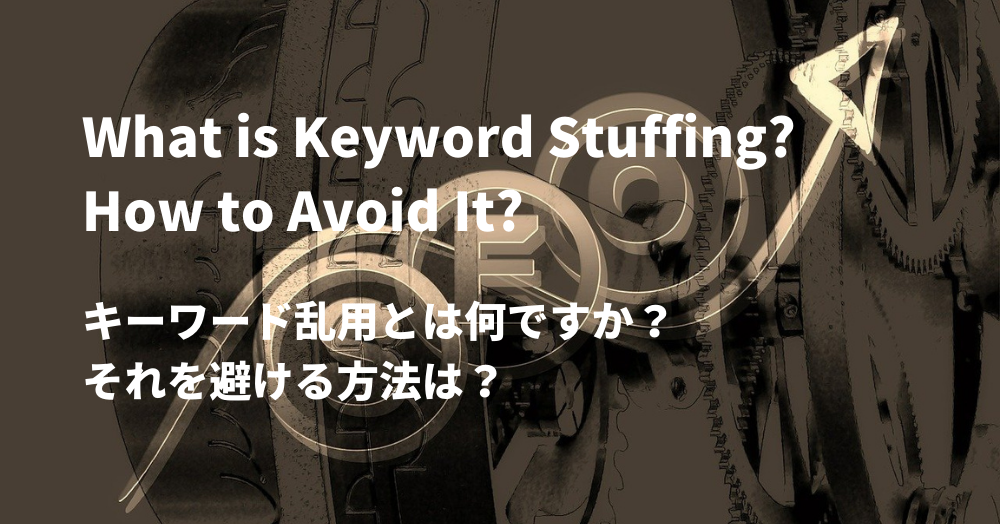キーワードの乱用 とは、一般的に、ユーザーに利益をもたらすことなく、そのキーワードでのページのランキングを上げることを目的として、ページ上にキーワードを過剰に使用し操作することを指す。2000年初め頃までは、この手法が有効だった。この手法では、キーワードをページ上の「隠しテキスト」として含めることも一般的で、白い背景に白い色のキーワードが実装されていた。これはユーザーからは見えないが、クローラーからは見えるというものだった。現在では、キーワード乱用はブラックハットSEOにおける手法の1つであり、もはや期待できない。
本文中にキーワードを大量に挿入することは、キーワードの乱用としても知られている。しかし、キーワードの詰め込みは、ウェブサイトが意味のある発言をできなくなり、使用されているコンテンツが陳腐化しページの付加価値がゼロになることが多いため、検索エンジンはキーワードの詰め込みが罰せられることを認識している。なぜなら、検索エンジンのアルゴリズムは、ユーザーのクエリや検索アクティビティに対して、常に最適で最も関連性の高いコンテンツ、機能、情報、レイアウトを見つけ出すように設計されているからである。
スパマーはキーワードの乱用をどのように使用しますか?
キーワードの乱用は、正確にこのキーワードまたは組み合わせがWebページで特に頻繁に使用されるという事実により、対応するキーワードまたはキーワードの組み合わせに対するWebサイトの関連性が高まることを前提としている。この方法の実装は、非常に多用途に行うことができる。そのため、可能な限り「詰め込む」のである。
- メタタイトル:ページタイトルにキーワードが何度も繰り返し表示される乱用。
- メタ説明:ここでも、キーワードが数回表示される。少なくともメタディスクリプションはランキング要素ではなくなったため、ここではキーワードの乱用はもはや役割を果たさない。
- メタキーワード:このメタタグでもキーワードの乱用が盛んに行われた。 キーワードと多くのロングテール用語が、メインキーワードと組み合わせてソースコードに保存された。場合によっては、ソースコードのメタキーワードが複数行にまたがっていた。遅くとも2009年以降、盛られたキーワードは意味がなくなったのである。当時Googleは、この日はもはや重要ではないと公式に発表したためだ。
- コンテンツ:Webサイト上の文章では、可能な限りすべての文章でキーワードが使われている。その結果、不自然な文章になり、キーワードによっては、意味のない組み合わせを助長することもある。
- ソーステキスト:この時点でもブラックハットSEOは働いており、ユーザーから見えない部分を適切なキーワードで埋め、検索エンジンのロボットに必要なフィードを与える。テキストのフォントサイズ「0」や白い背景に白いテキストもキーワードスタッフィングの一部であるが、今では検索エンジンロボットに確実にバレている。
- ALT属性:多くのキーワードは、長い間、画像のalt属性に配置されてきました。ALT属性は、ブラウザが画像を表示できないときや、目の不自由なユーザーがウェブサイトを「読む」ときに使用されるため、キーワードの詰め込みはSEOの観点からもよくありません。
- タイトルタグ:キーワードは、リンクや画像のタイトルタグに格納することもできます。詰め込みを行う場合、これらはmetaタグと同様に大量に挿入されます。
ページ上のSEO要素とランキング係数の詳細については、ガイドラインをお読みください。
検索エンジンは、Webページのキーワードの乱用をどのように定義していますか?
検索エンジンは、コンテンツ内で使用されているキーワードの頻度を割合で計算する。また、コンテンツ全体の範囲にも依存している。コンテンツの総量は、キーワードの頻度との関係で見る。いわゆるキーワード密度はここで評価される。長い間、この評価よりも、いわゆる TF / IDFファクター の方がずっと重要視されてきた。これは、そのキーワードがこの1つのコンテンツにどのくらいの頻度で存在するかということだけでなく、同じテーマを扱う他のキーワードに対してこの値がどのくらいの割合で存在するかも考慮されるのである。
さらに、この式内で比較すると、このキーワードがどのくらいの頻度で潜在的に他のページ内に表示されるかについても同じことが言える。キーワードの出現頻度が高すぎる場合、GoogleはWebサイトや特定のWebページのランキングに対して、アルゴリズムによる評価減や手動アクションを実施することができる。
Googleはキーワードの乱用についてどう言っていますか?
Googleのウェブマスターガイドラインには、ページの品質をより測定可能にするためのいくつかの異なる基準が含まれています。Googleのウェブマスター品質ガイドラインでは、SEOとWebサイトの所有者は誰でも、Googleの視点からGoogleのスパムガイドラインとスパム定義を見つけることができます。キーワードの乱用もここで定義され、語られています。特に、キーワードを繰り返し使用することによって、Webページの付加価値が損なわれている場合は、そのような用語の頻繁な使用は強く推奨されません。
Googleの観点からは、ページのランキングを大幅に損なう可能性があるため、自分のページにキーワードを無差別に入力することは避けてください。同じキーワードが頻繁に使用されるとテキストが読めなくなり、ユーザーにとって無関係になるため、ユーザーエクスペリエンスも大幅に低下する可能性がある。Googleは、隠しテキストなどの不正なテクニックにこだわらず、Webサイトのユーザーにとって価値のあるコンテンツを作成することを推奨している。ペンギンアップデート以来 、Googleもこの手法に積極的に対応し、スパム検出アルゴリズムに目をつけられたページを認識し、罰するようにしている。
キーワード乱用がSEOに与える影響とは?なぜキーワード乱用がランキングに悪影響を及ぼすのか?
キーワード乱用は、SEOに対する時代遅れで後進的な理解を表している。ユーザーに利益を与えることなく、ランキングを上げることはもはや不可能である。さらに悪いことに、特定のクエリは必要ないにもかかわらず、ランキングのために見出しや導入段落、視覚的なサブタグにそれらを異なる組み合わせで使用することも、キーワード乱用を意味する。
現在では、多くのSEO担当者が、特に意識することなく、最適化の名の下にこのような行為を実施することができます。このため、ユーザーエクスペリエンスやコンテンツの情報構成に貢献しないのであれば、 Webページのどの部分でもクエリを使うべきではない。
キーワード乱用に有効な対策は何ですか?
キーワード乱用の状況がコンテンツとして有効かどうかは、どんなツールがなくても人が理解できる。読み手の感覚を刺激せず、不自然な文章で同じ言葉を繰り返す、何の情報も与えないコンテンツであれば、ここにキーワード乱用が適用されているというだけで、可能性はある。
また、ユーザーが視線追跡、文法エラーの修正、記事の調子の変更のために大きなコンテンツブロックを断片に分割するのに役立つライティングエディターがたくさんある。これに加えてTF-IDFチェッカーを使用すると便利である。また、具体的にターゲットとしたクエリのSERPや、最高ランクのページのコンテンツをチェックすることも有効である。特定の用語のキーワード密度、TF-IDF結果と視線追跡、コンテンツの調整、感情分析、およびコンテンツで使用されているエンティティを確認すると役立つ場合がある。ここで重要なのは、自然であること、そして訪問者にとっての価値を創造することである。また、クエリの同義語を使用することで、乱用を実装をせずとも、特定のトピックに対してより良いコンテキストの関連性を作成することができる。
キーワード乱用とホリスティックSEOについて最後に思うこと
キーワードの乱用に効果はない。今日、ページを最適化するために、ウェブマスターとSEO担当者はウェブサイト上のコンテンツの意味的な文脈にもっと注目すべきであり、したがって、キーワードにはあまりこだわらない方がよい。常に改善される検索機能、例えばGoogle検索のために、ちょうどHummingbird Updateを考えると、比較は検索バーを介して行うことができるので、キーワード乱用などの技術は、彼らが発見されている場合、競争の直前に最高のパフォーマンスのためにドーピングするアスリートに匹敵するものである。
キーワード乱用が通用しなくなったことは、SEO業界にとってプラスに作用している。なぜなら、それは彼らを” 汚れた隅” から追い出し、検索エンジン最適化が汚い手口や詐欺ではなく、本物の職人技、経験、知識であることを再び明確にするからである。
Googleは、コピーされたコンテンツ、薄いコンテンツ、Webスパムをより良く区別することができます。その助けとなるのが、Googleが2009年に特許申請までした「Gibberish Score(ギブリスコア)」だ。さらに、Googleは現在、RankBrainで人工知能を使い、一度も行われたことのない検索クエリを評価するようになっている。そのため、検索エンジンの設計者がウェブサイトの分析に技術的なソリューションを使用し、キーワードを過度に使用した悪質なコンテンツをより迅速に摘発することも考えられる。
コピーライターやSEO担当者としてキーワードの乱用を避けたい場合は、TF-IDFツールやHemingway Editorなどの記事編集ツールに頼ることができる。用語の重み付けに基づいてテキストの関連性を判断するのである。中心的な役割を果たすのは、特定のキーワードの頻度ではなく、Googleで上位に表示された10~15のURLの中から、特定の検索クエリに使用された関連用語の頻度である。
ホリスティックSEOとして、今後も「キーワードスタッフィングガイドライン」の改善に取り組んでいきます。
What is Keyword Stuffing? How to Avoid It?
Keyword stuffing generally refers to the excessive and manipulative use of keywords on a page with the aim of improving the page’s ranking for that keyword without creating any benefit for the user. This technique worked until around the beginning of 2000. It was also common for this tactic to include keywords as “hidden text” on the page: keywords in white color were implemented on a white background. These were not visible to the user, but they were visible to a crawler. Nowadays, thankfully, keyword stuffing is a method in black hat SEO that is no longer promising.
The massive insertion of keywords in a body text is also known as keyword stuffing. However, because keyword stuffing often means that a website can no longer make a meaningful statement, the content used is obsolete and the added value of the page is zero, search engines recognize that keyword stuffing is punished. Because, Search Engine Algorithms are always designed to find the best and the most relevant content, function, information, and layout for the users’ queries and search activities.
How Spammers Use Keyword Stuffing?Keyword stuffing assumes that the relevance of a website for a corresponding keyword or combination of keywords increases due to the fact that precisely this key term or combination is used particularly frequently on a web page. The implementation of this method can be very versatile. So it is “stuffed” wherever possible:
引用:What is Keyword Stuffing? How to Avoid It?|Holistic SEO
・Meta Title: Here the keyword is repeated several times in the page title during stuffing.
・Meta Description: Here, too, the keyword appears several times. At least since the meta description is no longer a ranking factor, keyword stuffing no longer plays a role here.
・Meta Keyword: Keyword stuffing was also very popular in this meta tag. Keywords and many long-tail terms were then stored in the source code in combination with the main keyword. In some cases, the meta keywords in the source code spanned multiple lines. Since 2009 at the latest, heaped keywords have no longer been meaningful, because at that time Google officially announced that this day was no longer important.
・Content: In the texts on the website, the keyword is used in every sentence if possible. The result is the text that looks unnatural and, depending on the keyword, also sometimes promotes meaningless combinations.
・Source text: At this point, Black Hat SEOs also worked and filled the part of the website that was not visible to the user with appropriate keywords to give search engine robots the necessary feed. Font size “zero” for text or white text on a white background is also part of keyword stuffing but is now reliably exposed by search engine robots.
・ALT Attributes: Many keywords have been placed in the alt attribute of images for a long time. Since the ALT attribute is used when a browser cannot display images or when blind users want to “read” a website, keyword stuffing is not only bad for SEO reasons.
・Title Tag: Keywords can also be stored in the title tag of links or images. When stuffing, these are then inserted in large numbers, similar to the meta tags.
For more information about On-Page SEO Elements and Ranking Factors, read our guidelines.
What do Search Engines Define as Keyword Stuffing on a Web Page?
The Search Engine calculates the frequency of used keywords in the content in proportions. It also depends on the scope of the entire content. The total amount of content is viewed in relation to the frequency of the keyword. The so-called keyword density is assessed here. For a long time, the so-called TF/IDF factor is much more important than this assessment. This is not only considered, how often that keyword is present in this one content, but also in what proportion of this value is to other keywords that deal with the same subject.
In addition, comparing within this formula, how often this keyword appears within potential other pages. The same applies here too: If the keyword appears too often, Google can implement an algorithmic devaluation or manual action for the ranking of the web site or just the specific web pages.
What does Google Say About Keyword Stuffing?
Google’s webmaster guidelines include several different criteria to make the quality of pages more measurable. In Google’s Webmaster Quality Guidelines any SEO and Web Site Owner can find the Google’s Spam Guidelines and spam definitions from Google’s perspective. Keyword stuffing is also being defined and told here. The use of a term too often is strongly discouraged, especially if the added value of the web page is being harmed by this repetitive keyword usage practice.
From Google’s point of view, you should avoid filling your own pages with keywords indiscriminately, as it can extremely damage the ranking of the page. The user experience can also deteriorate significantly since a text is no longer readable when the same keyword is used frequently and is therefore irrelevant for the users. Google recommends creating valuable content for website users and not focusing on tricks such as hidden text or other illegal techniques. Since the Penguin update, Google has also actively taken action against this methodology and has tried to recognize and punish pages that have been noticed by the spam detection algorithms.
What does keyword stuffing mean for SEO? Why is keyword stuffing harmful to ranking?
Keyword Stuffing expresses an obsolete and backward understanding for SEO. It is no longer possible to raise rankings without actually benefiting the user. Even worse, although certain queries are not required, using them in headings, introduction paragraphs, visual subtags with different combinations of them for ranking purposes also means keyword-stuffing.
Nowadays, many SEOs can implement such practices under the name of optimization without being particularly aware. For this reason, you should not use a query in any part of the web page if it really does not contribute to the user’s experience and content’s information structure.
What measures help against keyword stuffing?
Without any kind of tool, a person can understand whether a keyword stuffing situation is valid or not for content. If the content doesn’t spark a sense for the reader and it always repeats the same terms with unnatural sentences, if it doesn’t give any information, simply saying keyword stuffing applied here is possible.
Also, there are lots of writing editors to help users divide big content blocks into pieces for eye-tracking, fixing grammar errors, and changing the tune of the article. Along with this, using a TF-IDF Checker can be useful. Also, checking the SERP for specifically targeted queries and the content of the best-ranked pages can help. Checking their keyword density for specific terms, TF-IDF Results and eye-tracking, content tune, sentiment analysis, and used entities in the content may help. The key here is being natural and create value for the visitor. Using synonyms of a query also can create a better context relevance for certain topics without any kind of stuffing implementation.
Last Thoughts on Keyword Stuffing and Holistic SEO
Keyword stuffing does not have a positive SEO effect. In order to optimize on-page today, webmasters and SEOs should focus more on the semantic context of content on the website and therefore less on the keywords. Due to the constantly improving search functions, e.g. Google search, just think of the Hummingbird Update, since comparisons can also be made via the search bar, techniques such as keyword stuffing are comparable to athletes who dope for best performance right before the competition wonder if they are discovered.
The fact that keyword stuffing no longer works has a positive effect on the SEO industry. Because it gets them out of the “ dirty corner” and once again makes it clear that search engine optimization is not about dirty tricks and scams, but about real craftsmanship, experience, and knowledge.
Google can distinguish better and better the copied content, thin content, and webspam. The company is helped by the Gibberish Score, for which Google even applied for a patent in 2009. In addition, Google now uses artificial intelligence with RankBrain to evaluate search queries that have never been made. It is therefore also conceivable that the search engine designers also use the technical solutions for the analysis of websites and thus exposes bad content with excessive use of keywords more quickly.
If you want to avoid keyword stuffing as a copywriter or SEO, you can resort to helpers such as TF-IDF tools or article editors such as Hemingway Editor. You determine the relevance of a text-based on term weighting. It is not the frequency of a certain key term that plays a central role, but the frequency of relevant terms that are used for a specific search query from the 10 or 15 best-placed URLs on Google.
As Holistic SEOs, we will continue to improve our Keyword Stuffing Guideline.


コメントを残す